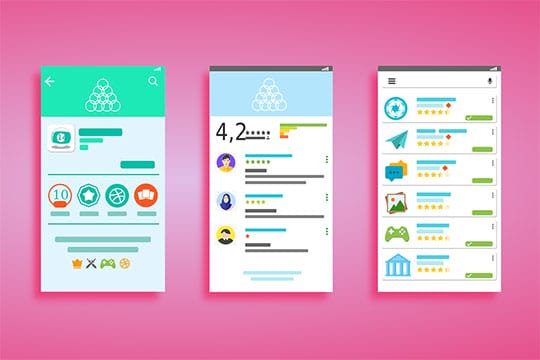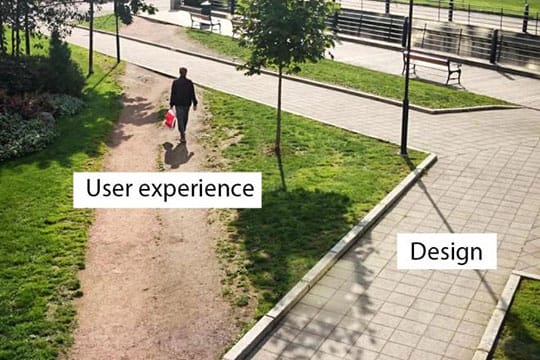In the industry, UI design and UX design are most commonly used, however, most often confused terms in web and app design. It’s common for people to use the terms UI and UX interchangeably, or sometimes inaccurately. But actually, they mean very different things. Both of these things are crucial for an IT product and work together. Even though they are integral to each other, their roles are quite different, including distinct processes.
If you’ve ever wondered what these two terms actually mean, and how they differ, then you’ve come to the right place. In this post, we’ll try to dig a bit deeper into both the concepts to get a better understanding of the differences between them. Read on to find what exactly does each concept means in the context of the tech industry and what are the key differences between them.
Before we consider the main differences between UI and UX design, let’s first define what each term means individually. UI design refers to the term ‘User Interface Design’, while, UX stands for ‘User Experience design’. Both these elements are important to a product/website and help users to get what they’re looking for. Despite their professional relationship, their roles are quite different; they refer to completely different aspects of the product development process and the designing part. In simple words, UI is all about how things look, whereas UX focuses on how things work.
The main problem arises in the word ‘design’ when people get confused with UI and UX design. For many people, the word ‘design’ is related to creativity, graphics, and colors, while its true definition lies in the product functionality as well as the process of making a product that provides a seamless experience to the users.
What is User Interface Design?

At a very basic level, the user interface (UI) is the graphical layout of an application. It is the series of pages, screens and visual elements like icons and buttons that enable a person/user to interact with a product. The UI design is a combination of content (text, images, documents, videos, etc), form (labels, buttons, checkboxes, drop-down lists, text fields, graphic design, etc), and behavior (what happens when the user clicks/drags/types). UI refers to the part of the site or an app that the user sees and clicks on. In short, UI design considers the feel, look, and interactivity of a product. It’s all about ensuring that the UI of a product is as intuitive as possible.
UI design focuses on transferring a product’s research, content, layout, and development into an attractive and responsive experience for users. It is purely a digital practice that considers all the visual and interactive elements of a product interface such as icons, buttons, typography, color schemes, and responsive design. The key objective of UI design is to guide the user visually through a product’s interface. Designing a UI includes selecting colors, images, defining brand/corporate identity, enhancing the look of the product and following the latest designing principles.
A UI designer makes technology easy as well as intuitive for users to use. They work on the areas where people directly interact with the product. They create interfaces that are structured and oriented to meet the needs of users rather than just facilitating technical solutions.
User Interface is the first thing on any website/app that grabs your attention when you visit the site. It also plays a vital role in the user’s decision to further visit the entire website or leave it. And that is why it is essential to pay attention to the UI design of your website/app.
Recommended for you: JavaScript Trends: How it Redefines Excellent User Experience.
What is User Experience Design?

User experience (UX) is the experience that the users have as they interact with the product. This includes everything from screens, keyboards, sounds, and lights. It encompasses all aspects of the user’s interaction with the company, its products, and its services. UX design is all about creating smooth and enjoyable experiences for users. While speaking about a website, UX refers to the content, systems, structure and the designing of the website.
The user experience refers to the interaction between the user and the product/service. And UX design covers all the elements that shape this experience. Creating/designing a UX means defining the way a product works and how it meets the needs of users. So, it is obvious that it should be comfortable, clear as well as user-friendly.
A User Experience designer thinks about the users, how the experience of a product makes users feel, and how easy it is for them to accomplish their desired tasks. The UX designers are accountable to ensure that the company delivers a product or service that meets the customer requirements and allows them to seamlessly achieve the desired outcome. They use the insights gained to constantly iterate and improve user experiences, based on both qualitative and quantitative research.
UX design is comparatively still a new field for many. It is required if companies want to succeed in attracting and retaining customers. The great user experience helps in enhancing customer satisfaction and trust in the long term. UX design also aims at improving the quality of interaction between the customer and the company.
UI vs UX Design – Understanding the Basic Difference

Even if UI and UX design are correlated and UI is an important part of the design, it is important to distinguish the user experience (UX) from the user interface (UI). Basically, UI includes all the elements that enable users to interact with a product or service. On the other hand, UX is all about the experience of the user while interacting with that product or service.
Let’s take an example. Consider your website/app as a journey. Every person/user that visits your website or downloads your app from finding it in the app store, through using the app and achieving their goals from the app is all taken on a journey. And this journey should be wonderful and enjoyable. So, you do not wish to throw all the related information on the first page of the website or screen of the app hoping that the visitor/user will pick it up from there. And this is exactly where a good user interface comes in the picture. You, as a tour guide, would take the user on a delightful journey through your app. And for this, you have to be able to shift and move their attention from one place to another guiding them, while creating a greater user experience.
“UI is a key part of UX that allows users to interact with your product and makes the first impression. However, it is important to remember that merely designing an attractive app does not guarantee high conversion rates; it is UX that addresses these concerns and other factors influencing user loyalty.” – as mentioned by Cache Merrill, the Founder & CEO of Zibtek, while discussing the differences between UI and UX in his recent press release.
UI vs UX Design – The Main Differences:

- The main difference between UI and UX design, to bear in mind, is that UI design is all about the look and function of the product’s interface, while UX design is all about the entire feel of the experience.
- The UI design is all about creating interactive, aesthetically-pleasing and intuitive interfaces; whereas UX design is about identifying and resolving user problems.
- UI deals with the quality of the user’s interaction with the product; while UX deals with the functionality and purpose of the product.
- The UI design has an artistic component as it involves the design of the product. UX design has more of a social component for communicating with users to understand their needs.
- Usually, UX design comes first in the process of product development, followed by UI.
- The UX designer first maps out the skeleton of a user’s journey and then UI designer fills it in with creative, visual and interactive elements.
- UI is specific to digital products while UX can apply to any type of product, service, or experience.
- UX is essentially a process, while UI is a deliverable.
- UI has more of a technical component to create the design components for the end-product. UX focuses on project management as well as analysis through the entire phase of conception, development, and delivery.
You may also like: Use of Artificial Intelligence (AI) in the Modern UI & UX Design.
The Bottom Line:

No matter what differentiates them, User Interface and User Experience are inseparable. Regardless of the definitions and division of function, they are essential parts of product development and delivery; rather they are an investment in the product or service. But does it mean that you can appoint a single person as a UX/UI designer who can complete the entire process of UX design? UI and UC design are parts of a process and it can be assigned to a single person. But, UX design is more than just graphic designing and requires a wider skillset. While a UX designer can create prototypes and coordinate with the UI team to design the product, a UI designer needs to have the skills to conduct market research and understand user behavior to design a product with an instinctive interface that users would love and use.





